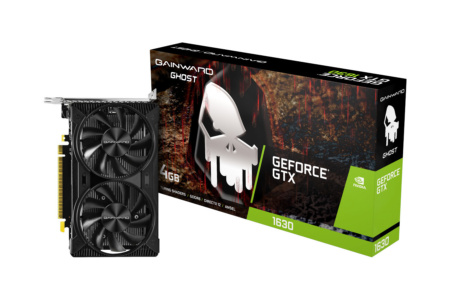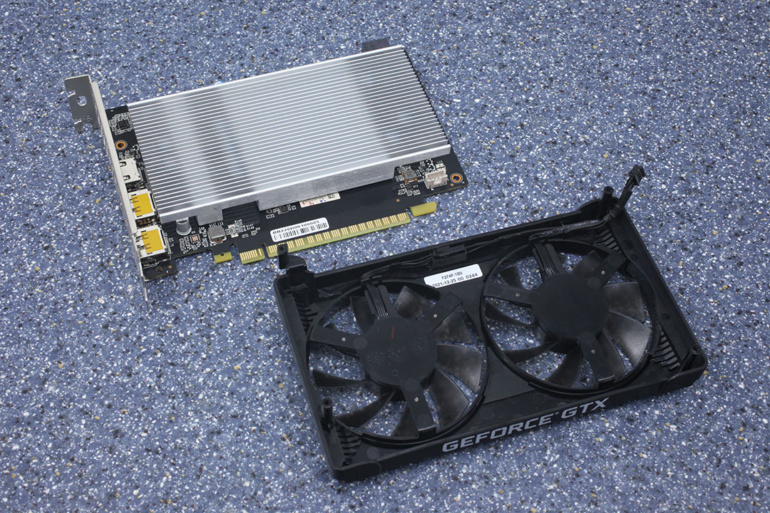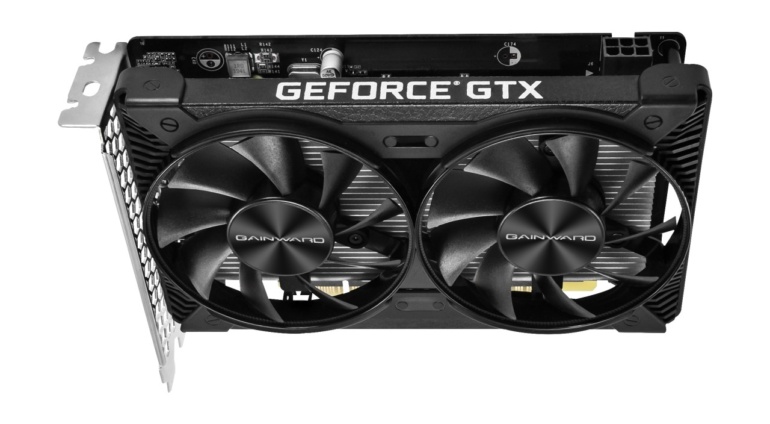
NVIDIA recently introduced a “super-budget” GeForce GTX 1630 video card with frankly poor performance at the level of the Radeon RX 6400 and GTX 1650 models, but a rather attractive price tag of $150. Our colleagues from Techpowerup managed to test the Gainward GeForce GTX 1630 Ghost video card based on this chipset, and we invite you to read the adapted translation of this review.

Characteristics
Today we will get acquainted with the Gainward GeForce GTX 1630 Ghost and this is really a real “ghost” from the past. Oddly enough, the GTX 1630 is a completely new product and is expected to end up as NVIDIA’s new entry-level 16-series device – based on the old “Turing” graphics architecture and without support for real-time ray tracing or DLSS.
The GTX 1630 is not only based on the older “Turing” architecture, but even its chipset is built on an older 12nm FinFET node solution. We can only guess why NVIDIA decided to launch such a product now. It’s possible the company, sitting on a mountain of 12nm TU117 chips designed for mobile GeForce MX SKUs, has decided to enter the desktop segment to exploit those stocks (but we’ll never know for sure). With this positioning, the GeForce GTX 1630 will compete with the AMD Radeon RX 6400 and Intel Arc A380.
The standard TU117 chipset features 16 “Turing” streaming multiprocessors, or 1,024 CUDA cores, 64 TMUs, 16 ROPs, and 128 bits of memory interface. But even the GTX 1650 can’t boast of such performance, because it has only 896 CUDA cores. The new GeForce GTX 1630 from today’s review only uses 512 CUDA cores. And that’s not all: NVIDIA halved the memory bus width (to 64-bit), but kept the memory size at the same level (4 GB). The operating frequency is significantly higher than the GTX 1650 – 1785 MHz versus 1665 MHz for the GTX 1650.
Gainward GTX 1630 Ghost has a simple monoblock cooling system with a pair of fans. Even though the typical power of the GTX 1630 board is only about 75W, Gainward has a 6-pin PCIe power connector so that the card is not subject to the electrical limitations of the PCIe slot design.

Visually, the card looks the same as the “older” Gainward GTX 1650 Ghost, which is not surprising because both cards use the same TU117 GPU (the difference is only in the number of active blocks). Two translucent fans are mounted on a matte black heatsink frame. The design of the Gainward card makes it easy to remove the cooler shroud, so users can easily change the fans themselves if they break.
There are no heat pipes or other modern cooling systems, but they are not really needed: the temperature is low, as is the noise level. As you can see from the thermal pads, the main heatsink not only cools the GPU chip, but also the memory chips and the VRM circuitry. Two free slots are required for installation, two DisplayPort 1.4 ports and one HDMI 2.0b are available to the user.

Testing
All games were tested at three resolutions: 1920×1080 (the most popular), 2560×1440 (quality between Full HD and 4K for owners of “optimal” systems) and 3840×2160 4K Ultra HD (for owners of the most advanced gaming PCs with high-quality monitors) ).
Cyberpunk 2077
God of War
Red Dead Redemption 2
The Witcher 3: Wild Hunt
Forza Horizon 5
Civilization VI
Average Gaming Framerate
performance per dollar
Results
The release of the NVIDIA GeForce GTX 1630 video card surprised a lot of experts, including us. The model was intended to be the best solution for budget PCs (like the Radeon RX 6400 and RX 6500 XT, as well as the Intel Arc A380), but the fall of the crypto market and the subsequent price cuts for higher-end cards put the new product in a frankly uncomfortable position.
Testing in games showed a radical lag behind the GeForce GTX 1630 from competitors – even the AMD Radeon RX 6400 turned out to be 60% faster, not to mention the GTX 1650, which at least looks logical. Naturally, from the model with the number “1630” you expect less performance than from the model with the number “1650”, but not as much. And the Radeon RX 6500 XT turned out to be twice as fast, on par with the GTX 1060 based on Pascal. Compared to the GeForce GT 1030, the GTX 1630 is three times faster.
Bottom line, we’re not sure if the GTX 1630 is suitable for gaming at 1080p even at low graphics quality. A significant reduction in the number of GPU cores, combined with a halving of the memory bus, which also halves the number of ROPs, has a very large impact on performance. I like that NVIDIA is using GDDR6 on the card, which makes up for a bit of the bandwidth lost compared to GDDR5, but it’s not enough.
AMD provides support for ray tracing in the Radeon RX 6400 and 6500 XT, while the GTX 1630 does not support this technology, since it is made on the Turing architecture, which does not provide ray tracing. This is not a problem in my opinion as ray tracing is more important for high end cards that have enough performance so you can get a little extra precision for your games. What would be helpful is support for NVIDIA’s DLSS scaling technology, which allows you to run games at lower rendering resolutions and upscale to your monitor’s native resolution, improving image quality with minimal performance loss thanks to machine learning.
Unfortunately, the TU117 GPU does not have tensor cores, so this feature will not be available either. AMD recently released its own scaling algorithms called “FSR” that work on all GPUs from all manufacturers, including the GTX 1630, so ironically, wide FSR support will come in handy for GeForce 16xx owners. NVIDIA has its own image upscaling tool called NVIDIA Image Scaling or NIS that works with the GTX 1630. It’s not bad, but offers less convincing results than DLSS and FSR.
Gainward’s GeForce GTX 1630 Ghost appears to be close to the reference implementation of the GTX 1630. The PCB design makes it clear that lowering production costs was the most important goal during the design phase. However, the card ran without any issues and the simple cooling solution handled the GPU heat with ease. Indeed, Gainward has picked up some fantastic fan settings. In standby mode, while working on the desktop, browsing the web, and playing media, the card turns off the fans. This ensures quiet operation.
When you start playing and the card reaches 60°C, the fans will start to spin slowly and quietly. This is the lowest noise level I’ve ever seen in a video card review. If you’re working in a quiet room with no other sources of noise, you’ll have to listen and focus only on the map to distinguish the noise from the fans. As soon as you move, the noise of clothes will prevent you from hearing the sounds made by the card.
NVIDIA designed the GTX 1630 with a very tight 75W power limit; during normal gaming, it even reaches only 50 watts. This is not achieved through a power-efficient design or a new processor node, as the RX 6400 uses a 6 nm process while the GTX 1630 uses a 12 nm process. Rather, it seems that disabling so many blocks, combined with a 64-bit memory bus using only two memory chips instead of four, significantly reduces power consumption, but also reduces performance. For a card of this type, it is important that it fits a PC of any shape and size, so that there are minimum power requirements – and this is exactly about the GTX 1630. The power limit of the board is 75W, and our testing confirms this limitation. We haven’t seen anything above 71W even at Furmark. The power limit cannot be increased for overclocking, since the maximum manual adjustment range is the same 75 watts.
Unlike the Radeon RX 6400, which only supports the narrow PCIe 4.0 x4 interface, the GTX 1630 comes with PCIe 3.0 x16 support, which will work much better with older PCs that only support PCIe 3.0.
At the launch of the AMD RX 6400, the lack of AV1 video decoding on the Navi 24 GPU was much discussed, some even saying the card was unsuitable for any use as a media PC. AV1 is a video encoder that is gaining popularity in recent times, replacing H.264 and H.265. While it would be nice to have one, I’m not sure AV1 will become “essential” in the foreseeable future. Video streaming services have automatic backups of older video codecs, and I’m sure they don’t want to lose much of their audience by requiring the AV1 codec. The GeForce GTX 1630 supports H.264 and H.265 video encoding and decoding acceleration, but does not support AV1 (as expected). The GT 1030 doesn’t support video encoding at all, so it’s an improvement from that point of view.
Acceleration worked very well. We got more than 11% performance without a significant increase in heat transfer or power consumption. Unfortunately, memory overclocking breaks after a certain point. Although 1675 MHz is stable all day long, as early as 1676 MHz will immediately crash the card. It appears that VBIOS does not have an appropriate timing profile for memory speeds above 1675 MHz, possibly due to the fact that it is not configured for Hynix GDDR6 memory chips installed instead of Micron GDDR6.

Verdict
Given the results of our testing, $150 is too high a price for this model, I can not imagine that this will interest many buyers. This card might be interesting if it costs $75. Yes, shocking, but that’s an adequate price for what it has to offer. I think for less than $100 I’m ready to consider the GTX 1630 for a media PC or performance system that doesn’t have integrated graphics. The GTX 1630 barely handles even very light games; if you don’t have too much money, I would pick the following cards in order: RX 570 4GB ($120), GTX 1060 6GB ($140), RX 6500 XT ($175), GTX 1660 Super ($210), and RTX 2060 ($250).
pros
- Three times faster than GT 1030
- Extremely quiet even under full load
- Fan stop at no load
- Very low power consumption
- Low temperature
- PCI-Express 3.0 x16 (as opposed to PCIe 4.0 x4 on RX 6400)
- Good overclocking potential
- Compact card, fits almost all cases
- Updated video engine compared to GT 1030/Pascal
- More modern connectivity options than older cards that predominantly have DVI
Minuses
- Very poor overall performance
- Very expensive for the performance offered
- Low board power level (75 W), manual settings prohibited
- Doesn’t make sense for a 6-pin power connector
- No DLSS support
- Limited memory overclocking (it is not clear whether this was done intentionally or a bug)
- No support for AV1 decoding
- Ray tracing not supported





